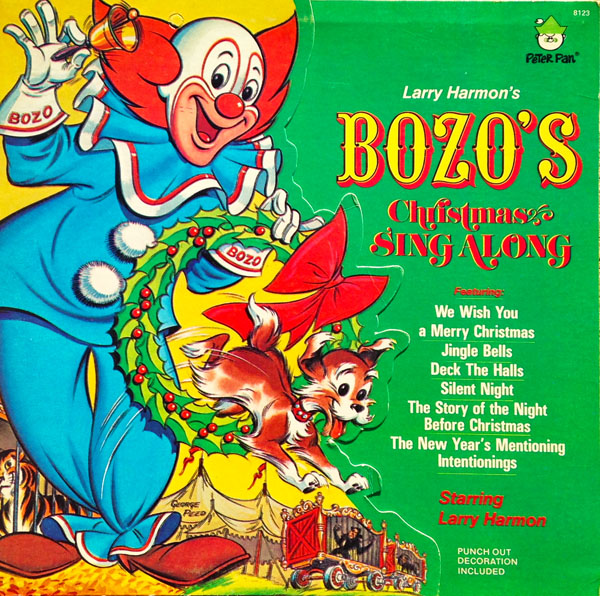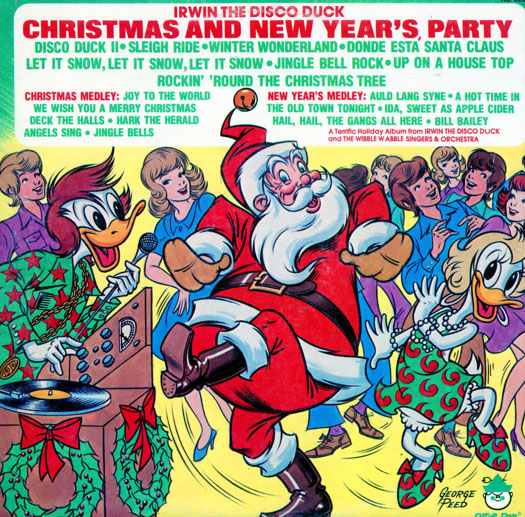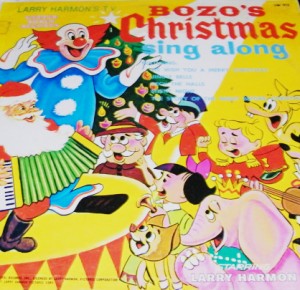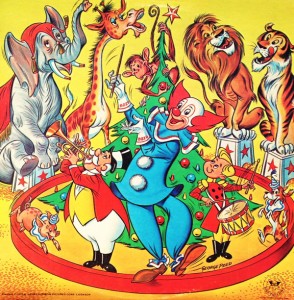Leave it to our “ol’ pal Bozo the Clown” to do an album with a New Year’s theme as well as Christmas. And like Oprah, Bozo endeavors to “teach us how to ‘be’.”

BOZO’S CHRISTMAS SING-ALONG PARTY
Little World Records LW-912 (Mono / 12” 33 1/3 RPM LP with Book / 1966)
Reissue: Peter Pan Records #8123 (Stereo / 12” 33 1/3 RPM LP / 1973)
Little World was one of many low-budget children’s labels of the baby boom era. All The Little World discs seemed to have the same basic musical combo (featuring an organ) and the same overall sound. Bozo and Romper Room were their heavy hitter licensees, but they also released a strange group of albums starring Ideal Toys’ Barbie-like Tammy doll and her friends, complete with awkward plastic poses on the covers.Producers: Jody Cameron, Larry Harmon. Cover Art (Peter Pan Reissue): George Peed. Running Time: 23 minutes.
Songs: “We Wish You a Merry Christmas,” “Jingle Bells,” “Deck the Halls,” “Silent Night.”
Spoken Word: “The Night Before Christmas,” “The New Year’s Mentioning Intentionings”.
Voices: Larry Harmon (Bozo, Santa Claus, Butchy, Big Shorty, Short Biggy, Professor Tweetypooper, Elvis, Wacko, Slippery Bly International Spy); Chris Allen (Belinda); Vocal Ensemble.
In the ‘60s, Bozo was king o’ the clowns (Emmett Kelly, Jr. notwithstanding). Actor/entrepreneur Larry Harmon negotiated the rights from Capitol Records to create what advertisers call a “toolbox” or “media kit,” offering local stations the materials and guidelines to bring Bozo to daytime TV as the live-action “Bozo’s Big Top” variety show, including Bozo cartoons, character outlines, games to play and like that. Stations didn’t have to start their local shows from scratch and Harmon could claim to have provided decent-quality kidvid all over the country.
Harmon also made a fortune as these local versions continued for decades and a Boston version was packaged for syndication The Chicago version, starring Bob Bell as Bozo, became such an institution, babies needed to be signed for Bozo tickets so they could see the show in person years later. Chicagoans took Bozo so much to their civic hearts, many thought he originated there. Bell also made many appearances as Bozo outside of his own show—even on Late Night with David Letterman in a very funny bit (“Lozenge?” “Please.” Hey, Bozo! Were STANDING in it!”)
Harmon’s cartoons helped usher in the beginnings of Filmation cartoon product. Lou Scheimer and Hal Sutherland met at Harmon’s company and learned a few things before striking out on their own and forming Filmation with Norm Prescott. Animated Bozo has the same lean figure and large head of many Filmation characters. Part of the cartoons’ appeal is that they feature some fine voice work by such giants as Paul Frees.
But no such luck on the Harmon Bozo records. On the Little World discs, just like Golden records, Harmon does all the voices except Belinda. He’s perfectly capable of handling some characters, but not virtually the whole cast. True, other voice actors of the day based their performances on a few loose impressions as Harmon does with his take on Peter Lorre, Edward G. Robinson and radio’s “Mr. Kitzle,” Artie Auerbach, but handling such a wide range is something that takes a more adroit voice artist.Bozo bubbles through organ-tooting version of a few public-domain Christmas songs, narrates “The Night Before Christmas” and by side two, welcomes in the New Year with a bromide-brimming set of “Mentioning Intentionings.” The album closes with a few bars of “Bozo’s Song” (by Alan Livingston and Billy May from the original Capitol records), played on bells.
This album was reissued on Peter Pan Records (with a stereo effect created by moving the mono tracks back and forth), but I cannot yet determine whether there was a connection between Peter Pan and Little World. The latter lists its address as 250 West 57th Street in New York, which was the location of CBS Records’s. Either this was a New York satellite office for Peter Pan or Little World just eventually sold their library. At any rate, you can hear some of the same Christmas songs on Peter Pan’s 1978 LP, “Exciting Christmas Stories with Scooby-Doo.”
GIVE A LITTLE LISTEN
“The New Year’s Mentioning Intentionings”
As alluded to in the intro, Jada Pinkett-Smith once said to Oprah, “You taught us how to ‘be’.” Perhaps that was Bozo’s golden goal back in 1965. Harmon joins himself as Butchy with Chris (“Hoppity Hooper”) Allen as Belinda. Looking back at the turbulent ‘60s, if ONLY everyone would have sat down and listened to Bozo’s whiz-bang wisdom and remembered what he always told us—just keep laughin’—perhaps there might have been a more Bozo-riffic world.

CHRISTMAS AND NEW YEAR’S PARTY
Irwin the Disco Duck
Peter Pan Records #8203 (Stereo / 12” 33 1/3 RPM LP / 1977)
Executive Producer: Martin Kasen. Producer: Ralph Stein. Associate Producer: Donald Kasen. Cover Art: George Peed. Running Time: 33 minutes.
Songs: “Disco Duck II,” “Sleigh Ride,” “Winter Wonderland,” “Donde Esta Santa Claus,” “Let It Snow, Let It Snow, Let It Snow,” “Jingle Bell Rock,” “Up On the House Top,” “Rockin’ Around the Christmas Tree,” Christmas Medley (“Joy to the World,” “We Wish You a Merry Christmas,” “Deck the Halls, “ “Hark! The Herald Angels Sing,” “Jingle Bells”), New Year’s Medley (“Auld Lang Syne,” “A Hot Time in the Old Town Tonight,” “Ida, Sweet As Apple Cider,” “Hail, Hail, The Gang’s All Here,” “Bill Bailey.”
Voices: Don Messick (Irwin); The Wibble Wabble Singers.
No one’s denying that Irwin the Disco Duck was a “tribute” to Rick Dees’ “Disco Duck” novelty hit. Peter Pan Records, though, turned their “Irwin” into a cottage industry for the family-run label. There was Irwin merchandise and over half a dozen Irwin albums (the first LP went gold). Irwin outlasted the disco era and was renamed Irwin the Dynamic Duck so he could do Star Wars-themed platters.
What’s cool about this record—and the reason it’s included here—is because the great Don Messick performs Irwin’s vocal duties, which amount to playing a party DJ. Messick had worked with children’s and budget record producer Ralph Stein in the late ‘60s, when they collaborated on an odd Golden album called “Jim’s Fairy Tales.” Stein produced many of the Irwin albums, so it’s likely that he cast Messick as Irwin. Irwin’s voice was also sometimes played by the fine New York actor, Bob Kalaban.
GIVE A LITTLE LISTEN
“New Year’s Medley”
This will give you an idea of how all of the Irwin albums sounded; they’re very much like ‘70s time capsules. The music production is quite good for a budget album. Maybe this holiday season, we’ll let Irwin the Disco Duck countdown to the New Year with us, before Ryan Seacrest does.
Happy New Year, everyone – see you in 2015.




 GREG EHRBAR is a freelance writer/producer for television, advertising, books, theme parks and stage. Greg has worked on content for such studios as Disney, Warner and Universal, with some of Hollywood’s biggest stars. His numerous books include Mouse Tracks: The Story of Walt Disney Records (with Tim Hollis). Visit
GREG EHRBAR is a freelance writer/producer for television, advertising, books, theme parks and stage. Greg has worked on content for such studios as Disney, Warner and Universal, with some of Hollywood’s biggest stars. His numerous books include Mouse Tracks: The Story of Walt Disney Records (with Tim Hollis). Visit 






















































“…..but handling such a wide range is something that takes a more adroit voice artist.” True! As soon as I read those words, all I could think of was my dear friend Mel Blanc! But Bozo had become Harmon’s “baby,” even though he didn’t do a good copy of Pinto Colvig’s original. After negotiating for the rights to the character, Harmon even went so far as to claim that he had CREATED Bozo–right down to the costume and makeup–in 1940! When Bozo’s REAL creator (Capitol exec Alan Livingston) heard about that, Livingston spoke out publicly and as a result, shamed Harmon into admitting the lie by acknowledging that Livingston was correct! Bozo was created in 1946 with the debut of Alan’s first Capitol children’s release, the story of Bozo at the circus. Harmon’s vocal ability was limited, as you point out, Greg. But there was no denying the man’s promotional skills!
The New Year’s Intentioning Mentionings. That was indeed sweet and wise.
I seem to recall Pinto Colvig was Bozo on Capitol Records. Was Harmon imitating Colvig?
Yes, Gerald, Pinto Colvig was the original Bozo on Capitol Records. Harmon may have been trying to approximate Colvig’s voice, but I could not say for sure. What Harmon did add to his Bozo was the use of more nonsense words like “Oops-Bazoops.” This was perhaps another clever way to give local Bozos a way of speaking extemporaneously. If you can’t think of something to say, just throw in a “Wowee-Kazowie!” or some such thing.
Larry Harmon was also responsible for a series of Laurel and Hardy cartoons in the mid-late ’60s. I believe Harmon imitated Stan Laurel’s voice in those.
Where I grew up, one of the local stations produced a “Bozo’s Big Top” series that ran more than fifteen years. It was pretty unambitious when compared to the Chicago show, but I liked our little “Big Top” because it was heavy on cartoons, mostly theatricals from Warner Bros., MGM, and Paramount. You could count on a Bugs Bunny and a Popeye just about every day — occasionally a black & white Fleischer Popeye! The only made-for-TV cartoons they ever ran were Beany and Cecil (one a day) and those awful Bozo cartoons. Every “Bozo’s Big Top” opened with one of those. We figured it was the price we had to pay to get to the good cartoons later in the show.
Larry Harmon somehow wound up owning and controlling the likenesses and names of Laurel and Hardy themselves, when negotiating to do the 1960s L&H television cartoons. I’m sure there’s a VERY interesting story there.
(Greg, thanks for finally getting in touch with me! The Leroy Holmes LP is coming soon! – William)
Yes, it’s Larry Harmon as Stan Laurel in those, with HB newcomer, Jim “Beany” McGeorge as Oliver Hardy (yet he’d play Laurel to Chuck McCann’s Oliver hardy in live appearances in the abysmal HB Scooby- . Hanna-Barbera produced those L&H cartoons of the sixties before returniong to L&H in those SD movies.Doo Moies)
As Laurel and Hardy became too ill to make further films, Stan kept an eye on other marketing (like the St. John comic book series) as a means of keeping the team in the public eye as well as bringing some income in for himself and Ollie (and later Hardy’s widow).
The Hal Roach films were constantly shown on television, but neither man received a cent from the broadcasts. Stan wasn’t particularly sure about Harmon, but needed an aggressive front man to create merchandising possibilities that could benefit L&H directly. He lived long enough to see the pilot for Harmon’s L&H series and thought it was awful, but was willing to put up with it.